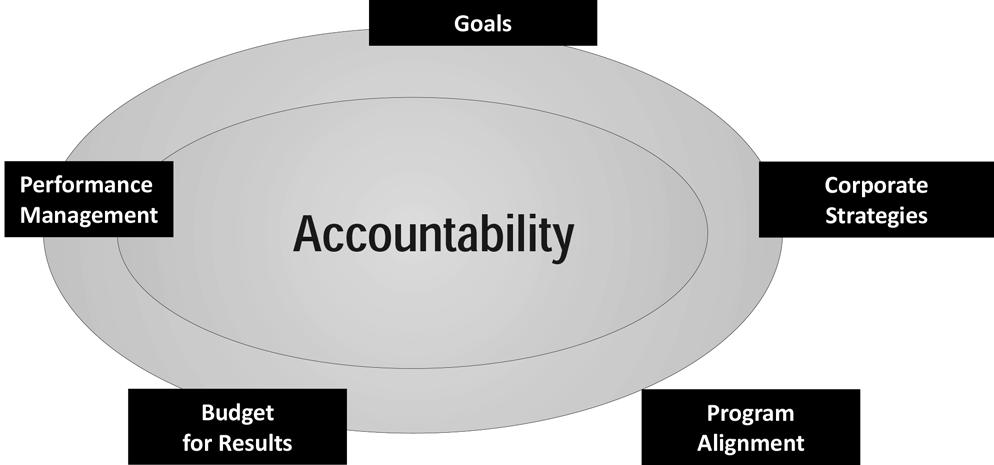
9 minute read
Improving the Budget Process
By Michael A. Bryant
There are many ways to improve the budget process that don’t require administrators to reinvent the wheel. It is acceptable and even common to implement proven best practices from other governments; but at the same time, the budget process should be customized to support your government’s business needs.
Advertisement
Develop a Strategic Plan
The operating budget is the largest policy in government. Its primary goal is to serve the general public and other stakeholders by clearly setting expectations for priorities and spending. When identifying improvements to the budget cycle, it is helpful to consider habit two of Stephen Convey’s 7 Habits of Highly Effective People1 – begin with the end in mind. The idea is to envision what cannot currently be seen, and it is a technique that is often used in creating an organization’s strategic plan or vision statement.
Strategic plans, which often span multiple years, help governments identify what is on the horizon. GFOA recommends that all governmental entities use some form of strategic planning to provide a long-term perspective for service delivery and budgeting, thus creating a strong linkage between the approved budget and broad organizational goals and community priorities.2 The organization’s strategic plan is its blueprint for how it intends to achieve its goals. The budget process should be designed to organize spending plans that cost out the resource needs to support implementation of the strategic plan.
Develop a Management Philosophy
A management philosophy defines the priorities and goals of an organization, educating employees and the community about the framework that guides the organization’s decision-making process. A management philosophy is an important element of the budget process. The budget process should be designed to elevate the priorities and estimate the cost required to achieve preferred outcomes. This framework is not limited to funding decisions; it can also influence policy discussion.
Mecklenburg County, North Carolina, implemented a management philosophy known as managing for results. This comprehensive and integrated management system focuses on achieving results for the customer and makes it possible for governments to demonstrate accountability to the communities they serve. (See Exhibit 1.)
Evaluate Performance
A performance management system tracks progress toward achieving the organization’s mission, vision, and goals. A comprehensive set of metrics can help organizations balance their business activities against their vision, strategy, and operations. With the support of a strategic plan, performance measures are used to align vision and mission with day-to-day work; evaluate business strategy; monitor operation efficiency improvements; and build organizational capacity.
Performance measures also serve as communication tools, showing exactly what the organization should measure to
Exhibit 1: Managing for Results
‘balance’ the financial perspective. When designing the budget process, previous performance results need to be considered. There should also be a strong linkage between performance measures and budget allocations, that an organization is funding programs and services that provide the best opportunity to meet goals and satisfy community priorities.
Mecklenburg County uses the Balanced Scorecard method to track progress toward achieving the organization’s goals and help put measures in the context of multiple community priorities. Performance results are illustrated with stoplight colors: green means performance is on target, yellow indicates mixed results, and red requires immediate attention.
Prepare the Budget
The focus can now shift to the preparation phase of the budget process. This often begins with an official budget kick-off meeting with departments; consider setting the right tone by combining the business meeting with fun activities. Mecklenburg County models the kick-off meeting after popular game shows. The last two years included games of Family Feud, budget bingo, and budget trivia, all hits with the department representatives. These kick-off meetings enable budget staff to provide instruction in a fun environment while not losing focus of the important business at hand.
Get Approval
The balancing act begins once the funding requests are submitted to the budget office and the executive team for
Exhibit 2: Straw Vote Spreadsheet
consideration. Mecklenburg County holds a two-day retreat with department heads during the latter half of the budget process to review and discuss each funding request. Although budget requests don’t receive responses, the event is beneficial for all involved, as the open dialogue between directors, the budget office, and the executive team enhances their understanding of funding requests. It also helps create an environment where department representatives can hear the resource needs of their colleagues and develop a better understanding of competing resources. The approval phase occurs before the manager presents the recommended budget to the governing body for review and adoption.
Transparency is often the goal for the decision-making phase of the budget process. In a political environment, elected officials often consider their constituents when making funding decisions. Most deliberations occur at budget workshops, where elected officials receive responses to their questions, helping them make informed decisions. In Mecklenburg County, the county commissioners take straw votes on the manager’s recommended budget (see Exhibit 2). Each elected official can ask a question regarding the recommended budget, seek clarity, and propose a funding adjustment. A motion to propose a funding adjustment to a particular item in the recommended budget does not require a second. A vote is taken, and if the motion passes, the adjustment is keyed into a spreadsheet that calculates the impact of funding decision on the property tax rate. At the end of this session, county staff is directed to develop the budget ordinance.

Other Considerations
Establishing Sub-Processes. Elected officials and the general public are generally not exposed to the entire budget process, and the decision makers are only exposed to the so-called tip of the iceberg. Developing a recommended budget requires several sub-processes such as non-profit funding and a review of user fees, which may require other strategies when designing the budget process. A number of factors influence those strategies, including citizen participation, different fiscal years, and separate governing bodies. Because of the attention to detail and effort required, governments might consider working on sub-processes outside of the traditional six-month budget season – a few months later would be ideal, helping balance the budget office’s workload throughout the calendar year and giving decision makers more assessment time. However, to the extent possible, the budget process does need to factor in all of the intricacies associated with the sub-processes.
The Intangibles. Regardless of how much effort and thought goes into improving the budget process, it will not succeed without teamwork, which involves factors that are difficult to measure or quantify. These intangible factors play a major role in the success of the budget process. The first is relationships, which are often overlooked in designing the budget process. Develop them by participating in department meetings and making an effort to learn more about the business you support.
Another factor is trust. The budget process is not about popularity, and you certainly cannot please everyone. But you can maintain trust and respect by being honest and forthright. With a high degree of trust and strong relationships, executive leadership, the budget office, and departments may agree to disagree and maintain a healthy partnership.
Strong communication is also essential, and different people prefer different communication styles. Technology such as SharePoint sites has enhanced the budget process, but don’t overlook the fundamentals. The majority of misunderstandings during the budget process are caused by a lack of communication, so don’t be afraid to ask questions when analyzing funding requests.
Finally, educate your supervisors about budget and fiscal responsibility. Employees are the organization’s most valuable asset. Mecklenburg County requires all supervisors to attend a budget and finance training, regardless of their direct involvement in the annual budget process. The curriculum highlights the importance of fiscal

Mecklenburg County’s Budget Process
(Fiscal Year: July 1 – June 30)
j Strategic Planning: Setting Goals and Priorities (September – December) j Strategic Planning: Corporate and Department
Strategies are Established and Refined (September – December) j Governing Body Budget Retreat: Annual Budget
Retreat with Governing Body (January) j Budget Kickoff: Official Start of the Budget
Process (January) j Budget Public Policy Meetings: Bi-Weekly
Meetings with the Governing Body to Discuss
Budget-Related Topics. (February – May) j Department Directors Budget Retreat: 2-Day
Workshop for Executive Team and Department
Directors to Discuss Department Budget Requests (April) j Recommended Budget Presentation: Managers’
Presentation of Recommended Budget to the
Governing Body (May) j Public Hearing: Citizen’s Comments on
Recommended Budget Sent to Governing Body (June) j Straw Vote Sessions: Governing Body Proposals and Voting on Adjustments to Recommended
Budget (June) j Budget Adoption: Formal Approval of Operating
Budget (June) j Program Evaluation: Performance Assessment of
Programs and Services (Ongoing) j Budget Monitoring and Reporting: Monitoring and Reporting of the Adopted Budget (Quarterly)
accountability and the role of supervisors in managing their departmental resources. Employees have noted on the course survey that the training is one of the most valuable courses they have attended and it provides insight into the annual budget process.
Review Processes Regularly
The organization’s financial policies should be routinely reviewed and updated so they stay current. Mecklenburg County practices a fiscal discipline strategy that is centered on its financial policies. Policies that are up to date provide good guidance for debt service, pay-as-yougo capital funding, and fund balance, and help ensure that your organization’s finances are in good fiscal shape. Mecklenburg County conducted an extensive assessment and revision of its financial policies shortly after the Great Recession, putting the county in the strongest financial position it has enjoyed in years. Mecklenburg County is well positioned to maneuver the next fiscal storm much better than the last. And as a result, the budget process provides funding flexibility for the county manager.
Conclusions
A long-term financial model is a must, given the revenue uncertainty that governments face. It helps governments run scenarios based on assumptions, and as the assumptions are tested, it can prepare governments for the future and place them on the course for obtaining financial resiliency.
There is considerable latitude in designing the budget process. It should help identify the organization’s operating costs over the next fiscal year and, ultimately, achieve its goals. The components of the budget process should be refined to ensure that the jurisdiction is responding to the current fiscal climate, as well as meeting the needs of stakeholders. At the end of the cycle, the government can survey the stakeholders to identify what went well, along with opportunities for improvement, and incorporate the results into the next fiscal year’s budget process. Continuous improvement will ensure that your organization has a robust budget process.
Notes
1.Stephen Convey, 7 Habits of Highly Effective People (London: Simon & Schuster Ltd. U.K., 1990) 2.See the GFOA best practices, Establishment of
Strategic Plans, Long-Term Financial Planning,
Multi-Year Capital Planning, and Budgeting for
Results and Outcomes, at www.gfoa.org.
Michael A. Bryant is the budget director for Mecklenburg County, North Carolina, and is a member of GFOA’s Committee on Governmental Budgeting and Fiscal Policy. Bryant has taught classes for GFOA and made presentations at the annual conference.
This article was originally published in Government Finance Review, October 2015 (www.gfoa.org).











